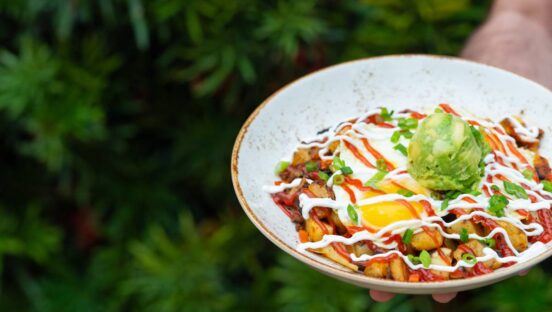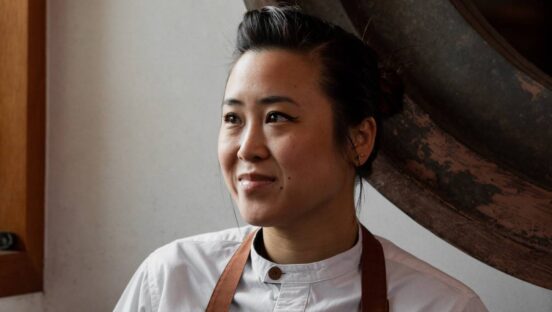

















14. Consumers buy by their values
The ongoing labor shortage has spotlighted just how low wages are within the service industry, and it’s prompted some companies to address the issue head-on. A number of restaurants are working to increase employee wages, bolster benefits, and enact policies that allow for a better work-life balance. Value-minded consumers, particularly younger ones, are taking notice of these efforts.
“A really high percentage of them have said they have paid attention to restaurants who treat their employees well, and those are the restaurants they want to patronize,” Olson says. “They are much more mindful of sourcing, too, because they’ve had the time to look into it.”
15. Sales growth levels out—but it’s not a bad thing
Market trends
Both staffing and sales growth find a new equilibrium.
Many restaurants are going to have a hard time posting numbers that beat quarterly sales increases from 2021—but that isn’t necessarily a reflection of bad business.
“Sales growth perspectives are going to moderate. Given the huge growth we’ve seen this year, we’re going to see it slowdown, especially year over year. Once we start overlapping Q2 of 2021, it’s going to be a lot tougher to post something at an increased rate,” Black Box’s Fernandez says.
Simply put, it would be almost impossible to drum up the level of excitement consumers felt during the past year. Brands that were able to navigate the pandemic and come out on the other side should expect a continued uptick in business, just not at the aggressive rate as the previous year.
16. The mix of on- and off-premises dining is here to stay
One of the major changes full-service restaurants had to make during the pandemic was shifting a large portion, if not all, of their business to accommodate off-premises dining. Carryout was already becoming an increasingly popular option in 2019, but the pandemic upended the dynamic nearly overnight—and it’s unlikely to change back.
“I think we’re not going back to the norms from pre-pandemic, and a lot of that is convenience,” Fernandez says. “It’s a lifestyle. A lot of people made investments in their off-premises business, and customers like it.”
Although restaurants continue to experience a return to in-person dining, the numbers won’t look the same as they did pre-pandemic. The convenience of being able to grab your favorite menu items to-go is too great of an obstacle to overcome.
17. Staffing improves, but at a cost
Staffing shortages have forced businesses to reconsider what they offer employees in terms of pay and benefits. But despite sweetening the proverbial pot, many restaurants are still far from fully staffed. “Things are getting better,” Fernandez says. “The caveat to that is that it will get better, but it will get expensive. We’re seeing labor costs and wages accelerate significantly. But in a way, if the industry is catching up to what others are offering, we have to match those offers as an industry to keep competitive in the labor market.”
And if more restaurants offer better benefits and pay, they’ll be more competitive across the board, allowing foodservice to steal talent away from other industries.
Into the Future
With 2022 right around the corner and a challenging 2021 behind us, it’s time to look toward the future for a sign of things to come. Along with a new year come new trends in food and beverage, hospitality, and technology. Will an existing tech solution make a surge as QR codes did in 2021? What libation will dominate menus at bars across the country? What will consumers seek in their dining experiences as they continue to emerge from COVID hibernation?
Five experts across various fields weighed in on what the new year has in store for restaurants, and their predictions range from F&B trends to market performance to consumer attitudes. Here’s what they had to say.
1. Caribbean Cuisine heats up
Food & Beverage
These foods, flavors, and beverages are expected to gain traction in 2022.
Consumers clung to familiar foods during the pandemic, but now they’re once again going global—and the warm islands of the Caribbean could be the first stop. “In summer 2021, the Caribbean American Restaurant Association launched its first-ever National Caribbean American Restaurant Week in New York City, with restaurants from over 17 states and 30 cities across the U.S. participating,” says Candace MacDonald, cofounder and managing director of creative strategy firm Carbonate.
But like any part of the world, the Caribbean is not a monolith. The region, which includes islands as well as countries like Belize and Guyana, features a number of diverse cultures and culinary traditions. African, Creole, Cajun, European, Chinese, and Latin American influences can all be found in Caribbean cuisine.
2. Pizza gets city-specific
Gone are the days when every pizzeria tried to replicate the New York style that has become synonymous with “good” pizza. Certainly, there are still restaurants that specialize in the large, hand-tossed, and thin-crusted slices, but it’s becoming more popular for restaurants to serve a wider variety of pies. And many are taking their inspiration from cities where pizza first originated.
“It’s no longer just New York thin-crust, Chicago deep-dish, and Detroit pan pizza; pizzaiolos are turning back to Italy and exploring its many regional specialties such as Sicilian sfincione [and] Roman pinse and pizza al taglio,” says Carbonate’s MacDonald.
Sfincione, known as the Sicilian New Year’s pizza, incorporates a layer of crisp bread crumbs. In Rome, pinse blends a mix of flours and uses a longer leavening process while pizza al taglio features a cold-fermented crust that is made of more water than most varieties.
“Most of these feature thicker crusts in various shapes and sizes, which hold up well to delivery, and toppings range from traditional to creative fusion flavors,” MacDonald adds.
3. Smoothie-style beers gain ground on IPAs
Smoothies and beer might sound like a strange combination at first, but the end result is angling to become the next big brew.
“After years of hazy IPAs, some beer makers are experimenting with smoothie-style beers, which have a thicker texture. These sweet-sounding brews are actually based on sours and packed with fruit purée after the first fermentation, creating a thick, smoothie-like or slushy-like consistency with a lot of fruit flavor,” MacDonald says.
Smoothie–style beers have been on the market for a while but are just now increasing in popularity. Though IPAs remain one of the more popular beers, imbibers are constantly looking for the next best thing, and these smooth-bodied, tart-tasting beers could be it.
In general, these beers are more refreshing than their hoppy counterparts, due in large part to their fruit content and sweeter flavor.
4. Nonalcoholic cocktails are bigger than ever
Younger consumers are drinking less alcohol than previous generations, but they still crave the social, jovial experience of going out for drinks with friends. Nonalcoholic cocktails have proved to be the perfect solution for those who are looking to stay alcohol-free without looking like a teetotaler.
“It’s become so much more inclusive for people who may not want to drink as much. Plenty of people are trying to cut back from how much drinking they did during the pandemic, but they don’t want to lose out on that social aspect of enjoying a cocktail,” says Sharon Olson, executive director of Y-Pulse, a research firm specializing in Gen-Z and millennial insights.
Sometimes bartenders will make substitutions with alcohol-free spirits like Seedlip and Ritual; other times, they’ll build the zero-proof libations from scratch. Either way, high-quality ingredients and mature flavors are key.
5. Chicken wings get stuffed
Over the past two years, demand for chicken wings has skyrocketed, which, combined with supply shortages, has led to steady price increases. Despite the higher price tag, wing popularity shows no sign of abating.
“We won’t go as far as saying, ‘chicken wings are so 2020,’ but last year was definitely the year we saw the explosion of wings on every menu, and even as an entire restaurant concept,” Carbonate’s MacDonald says. “Stuffed chicken wings are the 2022 extension of the trend, taking it from the fast-growing virtual restaurants into elevated dining rooms. Diners can get excited to see a familiar favorite reinvented by a chef’s skilled touch, feeding both a sense of nostalgia and discovery.”
Stuffed chicken wings have a long way to go before becoming mainstream, but a few pioneering establishments, including Emeril’s Restaurant in New Orleans, are ahead of the curve. At the French Quarter establishment, Miss Hay’s Stuffed Chicken Wings are filled with ground pork, chopped shrimp, mushrooms, onions, celery, cilantro, and fish sauce.
6. Ready-to-drink beverages stick around
Since the pandemic began, a premium has been placed on limited contact during service. Eliminating literal touchpoints can go a long way in bringing peace of mind to skittish guests. To that end, ready-to-drink beverages have become a popular menu addition.
“We created a custom canned cocktail, the Cara Cara Spritz, for a recent event in Orlando, and the attendees loved it,” says Dana Pellicano, vice president of F&B, global operations for Marriott International. “It was made with Grey Goose White Peach, rosemary, cara cara [oranges], and blood orange seltzer.”
COVID-era restrictions opened the door to premade cocktails, cocktail kits, and ready-to-drink beverages. Even as more guests venture back into restaurants, these drinks will remain relevant, thanks to the convenience factor.
7. Mobile device dining is here to stay
Technology
Digital solutions, especially apps, will become more engaging and user-friendly.
While the pandemic brought with it a slew of unknowns, one thing was clear when restaurants reopened: Customers were going to need their smartphones.
“Mobile dining is here to stay. Within food and beverage, it’s mobile dining that really enjoyed a pandemic boom, as restaurant customers across the country were forced to master the use of QR code technology and mobile menus in their favorite fine casual or traditional restaurant venue,” Marriott’s Pellicano says. “For those that worry that mobile ordering will usher in lower check averages due to the inability to upsell, take note: Mobile dining checks are traditionally 20 percent higher than traditional checks. Turns out, the allure of a side of fries or a scoop of ice cream remains irresistible in any format.”
And while some consumers may miss physical menus, the benefits of QR code–based menus are plentiful. It’s an easy way to cut down on the transmission of germs while also saving staff the step of sanitizing every menu when turning tables. Plus, it grants operators more flexibility in updating their menus.
8. Full service doubles down on digital engagement
Limited-service restaurants had a leg up on many full-service restaurants when the pandemic first hit. While many quick serves and fast casuals already had some sort of digital ordering function, whether through a website, proprietary app, or third-party provider, those options were less prevalent on the full-service side.
“In order to utilize some of the new technologies coming out, you need to plan ahead and really visualize how your restaurant will operate in 2022. They’re going to need to figure out how to build relationships with customers without being as dependent on third-party systems,” says Sastry Penumarthy, cofounder of loyalty and engagement platform Punchh.
And while many have now established some sort of claim in the digital realm, to remain competitive even more attention must be paid to the online space, particularly in terms of guest engagement.
9. Foodservice apps become more intuitive
The ubiquity of smartphones has erased the notion that older generations aren’t capable of fluently using modern technology. The more intuitive and well-designed the apps have become, the more welcoming they are to older generations. “These apps make is easier for the restaurants to know what their customers like,” Punchh’s Penumarthy says. “So, the easier the app is to use, a larger number of customers will use it. This is why we will continue to see restaurants push apps that are user-friendly.”
Consumers have come to expect easy-to-use apps, meaning restaurants should make sure their digital platform is straightforward and easy on the eyes, whether they’re using a third-party provider or an in-house program.
10. Apps get personal
Just as consumers crave convenient ways to order, pay, and receive their food, they’re also seeking digital experiences tailored to them. Dedicated apps and other platforms that store details like favorite menu items and customized orders make it easier for customers to order and offer operators a means to target promotions and reward customers for their loyalty. “I think we will emerge from this [pandemic] a little bit smoother as we approach the new year. At that point what will happen is that personalization will become the main way to differentiate what the customer’s experience is going to be like,” Penumarthy says.
11. Private dining options abound
Consumer habits
Check averages might even out, but consumers are eager to return to dining rooms.
Having missed out on travel for nearly two years, consumers might be eager for a vacation, but they’ll still want to ensure they’re staying—and dining—in a safe, clean environment. The days of being crammed shoulder to shoulder at a packed bar are gone, but hotels are in an enviable position to accommodate social distancing, thanks to existing private dining options with more space to spread out.
“We are seeing an interest from our guests for hotels that are upping their game with really creative private dining options, like the private floating cabana dinner at Wailea Beach Resort in Hawaii, custom-built private dining cottages at JW Marriott Los Angeles L.A. LIVE, and Dining Domes at Delta Hotels Victoria Ocean Pointe Resort in Canada,” says Marriott’s Pellicano.
12. Check averages start to plateau
Despite COVID-era business declines, check averages have increased overall. Various factors come into play. Online ordering can increase upsell opportunities, restaurants might pass higher food costs onto the consumer, and stimulus checks could have given some consumers more spending power. Whatever the reason, the steady rise isn’t sustainable.
“There has to be some sort of plateau because we cannot sustain the increases at this rate,” says Victor Fernandez, vice president of insights for restaurant analytics firm Black Box Intelligence. “Restaurants are becoming less competitive from a pricing standpoint compared to cooking meals at home.”
Eventually the cost of dining out will become too expensive to justify if it keeps increasing in the manner it currently is. Expect customers to spend less in the coming year.
13. Gen Z ditches the kitchen
The pandemic undoubtedly pushed people of all age groups to spend more time in the kitchen. From baking homemade bread to building elaborate sushi rolls, consumers had to get creative when dining rooms shuttered last year. But as recent data indicates, people—particularly those in the younger demographic—are champing at the bit to dine out again.
“They’ve gotten good at cooking, they’ve been eating at home, but they can’t do those amazing ethnic foods,” Y-Pulse’s Olson says. “They can’t do things that have a complicated technique.
Even though the food might taste simple, delicious, and [be] farm to table, it’s not that easy to replicate at home.”
In the new year, operators should be ready for Gen Z and young millennials to be among their most enthusiastic customer base.












